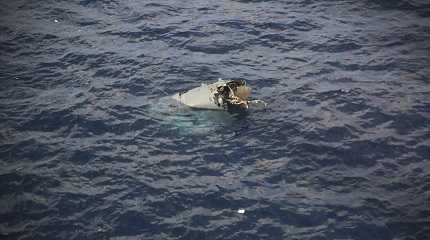
TOKYO (AP) — A crew member who was recovered from the ocean after a U.S. military Osprey aircraft carrying eight people crashed Wednesday off southern Japan has been pronounced dead, coast guard officials said.
The cause of the crash and the status of the seven others on board were not immediately known, coast guard spokesperson Kazuo Ogawa said.
The Osprey was carrying eight crew and is an Air Force aircraft, a U.S. official who was not authorized to speak to the media said on condition of anonymity. While the Marine Corps flies most of the Osprey aircraft that are based in Japan, the Air Force also has Ospreys deployed there.
Earlier reports had said the aircraft was carrying six or eight people.
The Osprey is a hybrid aircraft that takes off and lands like a helicopter, but during flight can rotate its propellers forward and cruise much faster like an airplane.
Ospreys have had a number of accidents in the past, including in Japan, where they are deployed at both U.S. and Japanese military bases. In Okinawa, where about half of the 50,000 American troops in Japan are based, Gov. Denny Tamaki told reporters Wednesday that he will ask the U.S. military to suspend all Osprey flights in Japan.
Coast guard spokesperson Ogawa said it received an emergency call Wednesday afternoon from a fishing boat near the crash site off Yakushima, an island south of Kagoshima on the southern main island of Kyushu.
Coast guard aircraft and patrol boats found one person identified only as a male who was later pronounced dead by a doctor at a nearby port, he said. They also found gray-colored debris believed to be from the aircraft and an empty inflatable life raft in an area about 1 kilometer (0.6 mile) off the eastern coast of Yakushima, Ogawa said.
The coast guard said it planned to continue searching through the night.
Chief Cabinet Secretary Hirokazu Matsuno said the Osprey disappeared from radar a few minutes before the coast guard received the emergency call. The aircraft requested an emergency landing at the Yakushima airport about five minutes before it was lost from radar, NHK public television and other media reported.
NHK quoted a Yakushima resident as saying he saw the aircraft turned upside down, with fire coming from one of its engines, and then an explosion before it fell to the sea.
Prime Minister Fumio Kishida said he planned to seek a further explanation from the U.S. military, but declined to say whether he would seek a temporary suspension of Osprey operations in Japan.
Ogawa said the aircraft had departed from the U.S. Marine Corps Air Station Iwakuni in Yamaguchi prefecture and crashed on its way to Kadena Air Base on Okinawa.
Japanese Vice Defense Minister Hiroyuki Miyazawa said it had attempted an emergency sea landing and quoted the U.S. military as saying its pilot “did everything possible until the last minute.”
U.S. and Japanese officials said the aircraft belonged to Yokota Air Base in western Tokyo. U.S. Air Force officials at Yokota said they were still confirming information and had no immediate comment.
In December 2016, a U.S. Marine Corps Osprey crashed off the Okinawa coast, injuring two of the five crew members and triggering complaints among local residents about the U.S. bases in Okinawa and the Osprey’s safety record.
A U.S. Marine Corps Osprey with 23 Marines aboard crashed on a north Australian island in August, killing at least three and critically injuring at least five during a multinational training exercise.
It was the fifth fatal crash of a Marine Osprey since 2012, bringing the total death toll at that time to at least 19.




